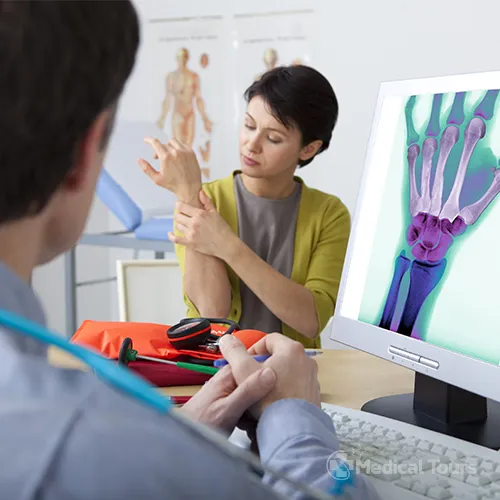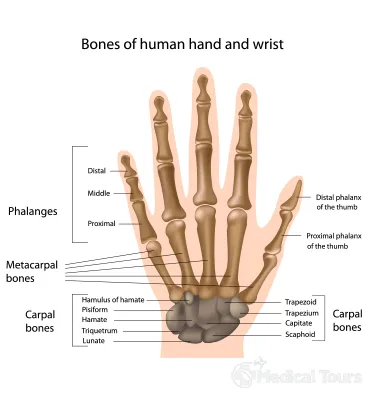Hand and wrist surgery costs less in India as compared to other western countries. Most of the foreign patients choose India for the quality orthopedic treatment and their satisfaction. The cost of hand and wrist surgery in India varies between USD 4,000 (INR 3,17,218) and USD 7,000 (INR 5,55,131). It is dependent on the hospitals and the complexity of the treatment.
Hand and wrist problems can affect anybody, young or old, and they can influence your employment and quality of life. These complicated sections of your body equip you with the power to produce significant force for activities such as rock climbing. They also provide you with the fine dexterity required to perform a musical instrument, making them a perfect blend of power and grace. Orthopedic surgeons are experts in the difficulties of microvascular surgery as well as the anatomy of the hand and wrist. This allows us to diagnose and treat the little bones, delicate nerves, arteries, and tendons that may be causing your hand or wrist pain.
Surgical or non-surgical treatment options may be indicated based on the diagnosis. Wrist arthroscopy allows your doctor to examine the ligaments and cartilage surfaces of the bones. Some ligaments have a good blood supply and may be mended and healed, while others do not have a blood supply and cannot be fixed or healed, thus they are removed.
A small camera attached to the end of a narrow tube is placed directly into the rear of the wrist joint through a small hole in the skin during the process. The image is projected onto a television screen for optimal viewing.
Muscles and tendons regulate the mobility and power of your hand and wrist: The flexor group controls the bending of your fingers and wrist on the inside or front of your arm; these pass over the front of your wrist and are held in place by the flexor retinaculum, or carpal tunnel ligament, which is a strong fibrous band.
The hand can open thanks to the extensors on the outside or back of your forearm. The lumbricals and interossei muscles in your hand enable precise movement. A layer of synovium, the same tissue that lines your joints, covers the tendons in your hand. A tendon sheath, like the protective coating of a bicycle's brake cable, protects the tendon and synovium.
Your hand's sense of touch is supplied by two primary nerves: the median or carpal tunnel nerve runs through the carpal tunnel ligament and provides sensation to most of your hand (from your thumb to half of your ring finger). It also gives muscles near the base of your thumb strength.
Your ulnar or funny bone nerve provides sensation to your little finger and part of your ring finger, as well as powering all your hand's little muscles. Blood is also supplied to your hand via two arteries (radial and ulnar). These are located on the palm side of your wrist. When taking your pulse, the radial artery (near your thumb) is frequently used. The other side of your wrist's ulnar artery is significantly more difficult to feel.
Although you will only be in the hospital for one night, your wrist will take several months to fully heal. Your wrist will be immobilized for two to six weeks while you heal, to improve wrist movement and hand function. Your physiotherapist or hand therapist will explain what you can and cannot do with your replacement joint, as well as how to maintain its health.
Let us know about the risks:
This wrist surgery is one of the risks, although it is not the only one:
People with arthritis-related difficulties in their hands and wrists do not always require surgery. However, for those who require it, surgery can aid in the relief of discomfort and enhancement of hand function.
Whether surgery is required or not, the following factors must be considered:
Carpal tunnel syndrome, trigger finger, Dupuytren's contracture, and arthritis of the base of the thumb are all conditions that may benefit from surgery.
Carpal tunnel syndrome develops when the median nerve is pressed on the carpal tunnel ligament as it passes through your wrist. Pins and needles and numbness in your fingertips are the outcome of this. Sometimes surgery is required to relieve pressure on the nerve. The carpal tunnel ligament is split under local anesthesia to accomplish this. It is unlikely that you will need to spend the night in the hospital.
Following carpal tunnel surgery, after the operation, you may need to wear a large bandage on your wrist and hand for a week or two. Within 10–14 days, your stitches will be removed. You can use your fingers and thumb at this time, but heavy work should be avoided. It is critical to move your fingers to avoid the nerves and tendons becoming entangled in any scar tissue that may form following your surgery. It should take less than a month for you to recover from the surgery's effects, however, it may take longer to regain all your sensations, especially if you have had carpal tunnel syndrome for a long period. The scar may pain and be sensitive for a few months in a tiny percentage of people, but this normally goes away without further treatment.
Dupuytren's contracture is a condition in which tissue forms in the palm and fingers of your hand. It is usually painless and simply causes skin nodules, but it can also cause bands to grow on your fingers, causing them to curl down into your hand. You may require surgery to remove the tissue and free your fingers, though this is not always achievable. You will not have to stay in the hospital because the procedure is usually done as a day case.
After a fasciectomy for Dupuytren's contracture, your skin will take two to three weeks to recover, and you may need up to 12 weeks to regain full use of your hand. A hand therapist will examine you and begin exercises while monitoring your movement and function. You may need a night extension splint, but this is not usually necessary.
The affected finger can often flex properly but becomes trapped in a curled position if you have a trigger finger. This is caused by a thickening of the tendon that permits your finger to flex, causing it to become caught in the tunnel where it enters your finger. You may need to use your other hand to help 'trigger' your finger straight - hence the name. You may be directed to a hand therapist for the creation of a splint to prevent your finger from triggering while you are using it. In most circumstances, a local injection is beneficial. In most circumstances, a local injection is beneficial. If this fails, a modest day-case procedure to open the tunnel and liberate the tendon may be required. In one to two weeks, you should be back to normal.
The tendons that control your hand and wrist are divided into two groups: Extensor tendons open your fingers whereas flexor tendons allow you to grip and curl your fingers into a fist.
Tendon rupture occurs when one or more of these tendons tears or snaps. Tendon rupture in the hand and wrist is uncommon, and when it does happen, it is usually due to rheumatoid arthritis or another inflammatory arthritis. If the surgery is to be effective and to prevent the other tendons in your hand from rupturing, you will need to start treatment right once.
In many situations, the ruptured tendon is repaired with undamaged flexor tendons from other fingers. If the tendon bursts due to rubbing against a rough bone in your wrist, the bone must be smoothed or removed to prevent the repaired tendons from rupturing again.
After your operation, a bandage will keep your wrist from moving. It will protect the region and provide pain relief. Arthroscopy would not necessitate an overnight stay in the hospital. Fingers may move freely, and this movement helps to reduce edema and rigidity. Your surgeon will walk you through the therapy, medication, healthy exercise, and any work restrictions. Raising the wrist after wrist surgery is crucial to avoid swelling and pain
The following are some of the most important advantages of hand and wrist surgery:
There may be some drawbacks to hand and wrist surgery. Following are some of the most important disadvantages of hand and wrist surgery:
If you are generally healthy, the chances of a major complication from the operation are extremely low. Because some people can get an infection, if you notice any symptoms, go straight to your doctor for treatment.
With so many bones, ligaments, tendons, and joints needed to function the hands and wrists, there is substantial potential for injury. In fact, hand and wrist injuries are one of the most common ailments of athletes. Unfortunately, delays in diagnosis and treatment can lead to long-term problems or even permanent disability. Here is a list of some of the most common injuries athletes experience.
Wrist replacement is also known as wrist arthroplasty. This is a procedure in which the surgeon removes the injured bone and cartilage from the joint. These bones are regenerated with metal and plastic implants. The main reason for doing this procedure is to create a steady range of motion and reduce pain.
Carpal tunnel syndrome is a sign of collision of the main nerve cells and is caused by pressure on the median nerve. This nerve passes into the wrist called the carpal tunnel. When this nerve becomes injured, it can cause weakness and uncomfortable problems in the wrist.
If you are experiencing pain and discomfort in your hand and wrist, you should consult your joint replacement doctors. After a complete examination, the doctor will advise the treatment. However, everyone having pain in the hand and wrist need not undergo surgery as they can be treated with medicines, injections, physiotherapy, wearing splints, taping etc.
Recovery time can range from weeks to months, and sometimes longer. It depends on the type of surgery you have and the severity of your condition. After surgery, you should have regular follow-up with your doctor to keep up with your progress and healing.

